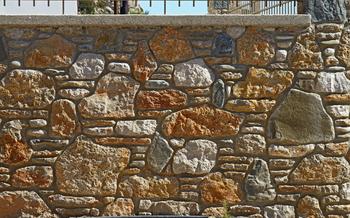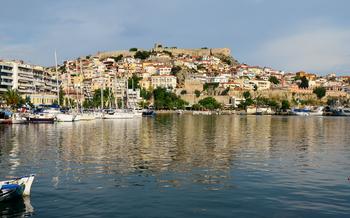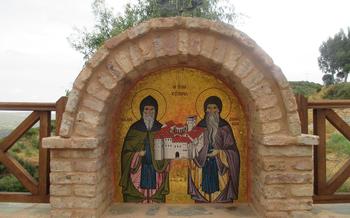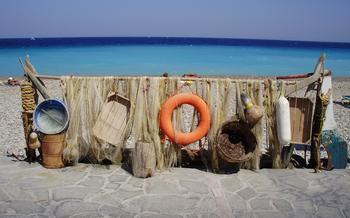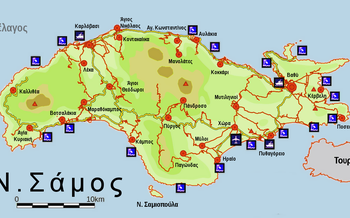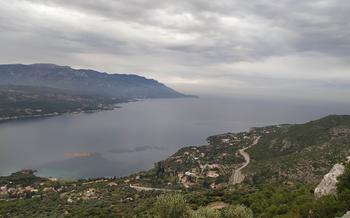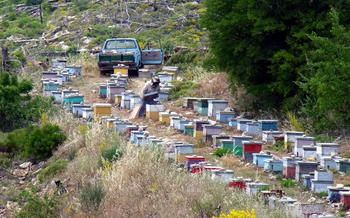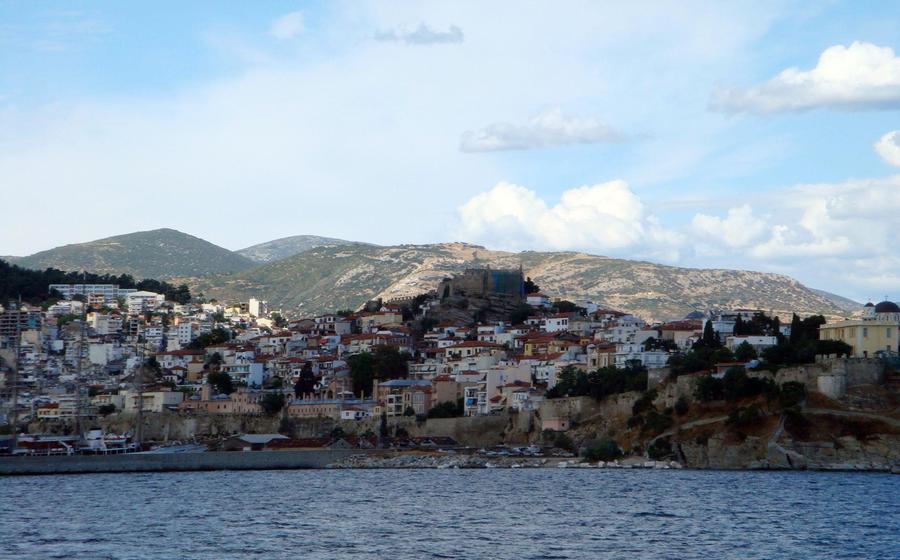
The Monastery of Ikosifoinissa
- History of the Monastery of Ikosifoinissa
- Architecture and Art of the Monastery
- Monastic Life at Ikosifoinissa
- Pilgrimage to the Monastery
- Getting to the Monastery
- Things to See and Do at the Monastery
- Where to Stay and Eat
- Shopping at the Monastery
- The Surrounding Area
- Local Festivals
- The Monastery's Library
- The Monastery's Museum
- The Monastery's Gardens
- The People of the Monastery
- Insider Tip
History of the Monastery of Ikosifoinissa
The Monastery of Ikosifoinissa, perched on a hilltop overlooking the Aegean Sea, holds a rich and intriguing history that dates back to the 10th century. According to legend, the monastery was founded by a group of monks who were guided by a miraculous icon of the Virgin Mary. They believed that the icon had been painted by Saint Luke the Evangelist himself, and they attributed its discovery to a series of divine signs.
The monastery quickly became a popular pilgrimage site, and its fame spread throughout the Byzantine Empire. During the Ottoman period, the monastery faced significant challenges, including persecution and confiscation of its properties. However, it managed to survive and even thrive, thanks to the unwavering faith and resilience of its monks.
In the 19th century, the monastery underwent a major restoration, which saw the addition of new buildings and the renovation of the existing ones. Today, the Monastery of Ikosifoinissa stands as a testament to the enduring power of faith and the resilience of the human spirit.
Architecture and Art of the Monastery
The Monastery of Ikosifoinissa is renowned for its exceptional architecture and stunning artwork. The centerpiece of the monastery is its domed church, which features a series of exquisite frescoes depicting biblical scenes and the lives of the saints. These frescoes are considered to be some of the finest examples of Byzantine art in Greece and are a testament to the skill and devotion of the artists who created them.
The exterior of the monastery is adorned with intricate carvings and sculptures that depict various religious figures and symbols. These carvings add a layer of depth and texture to the monastery's facade, making it a feast for the eyes. The impressive bell tower, which rises above the rest of the monastery, is a striking feature that can be seen from miles away.
In addition to the church, the monastery complex includes a number of other buildings, including cells for the monks and nuns, a refectory, and a library. These buildings are all well-preserved and provide a glimpse into the daily life of the monastery's inhabitants. The monastery also boasts beautiful gardens that are filled with a variety of flowers, trees, and shrubs. The gardens offer a peaceful and serene atmosphere, making them the perfect place to relax and contemplate.
Monastic Life at Ikosifoinissa
The monks and nuns of the Ikosifoinissa Monastery live a life of prayer, contemplation, and service. Each day begins with the morning prayers, which are followed by a period of work. The monks and nuns work in the fields and gardens, tend to the animals, and perform other tasks necessary to maintain the monastery. In the afternoon, they gather for more prayers and spiritual study. The day ends with the evening prayers, which are followed by a simple meal.
The monastic life is not easy. The monks and nuns live in simple conditions, and they work long hours. However, they find great joy and fulfillment in their lives. They are grateful for the opportunity to serve God and to live in a community of like-minded people.
The monastery plays an important role in the local community. The monks and nuns provide spiritual guidance and support to the people of the surrounding villages. They also offer practical assistance, such as food and shelter to those in need. The monastery is a place of peace and tranquility, and it is a welcome refuge for those who are seeking a closer relationship with God.
Pilgrimage to the Monastery
Ikosifoinissa is a significant pilgrimage site for Orthodox Christians from all over the world. The many miracles that have been attributed to the icon of the Virgin Mary have made the monastery a popular destination for those seeking spiritual healing and guidance. Pilgrims come to the monastery to pray, light candles, and ask for the intercession of the Virgin Mary. They often leave offerings of money or gifts in gratitude for her blessings.
There are several rituals and traditions associated with pilgrimage to the monastery. Pilgrims typically walk the last few kilometers to the monastery on foot, as a sign of humility and devotion. They also often spend the night at the monastery, in order to attend the morning prayer service and receive a blessing from the monks or nuns.
Making a pilgrimage to Ikosifoinissa is a deeply spiritual experience for many people. It is an opportunity to connect with their faith, to seek guidance and healing, and to experience the beauty and peace of the monastery.
Getting to the Monastery
The Monastery of Ikosifoinissa is located in the mountains about 25 kilometers from the city of Kavala. There are a few different ways to reach the monastery, depending on your budget and preferences.
The most convenient way to get to the monastery is by car. The drive takes about 30 minutes, and there is plenty of free parking available at the monastery.
If you don't have a car, you can also take a bus from Kavala to the village of Neo Karvali. From there, you can either walk to the monastery (about 3 kilometers) or take a taxi.
There are also a number of tour operators that offer day trips to the monastery from Kavala. This is a great option if you want to learn more about the monastery and its history.
The best time to visit the monastery is during the spring or fall when the weather is mild. The monastery is open to visitors every day of the week, but it is important to check the website or call ahead to confirm the hours.
When visiting the monastery, it is important to dress modestly and to be respectful of the monks and nuns. Visitors are also welcome to make a donation to the monastery.
Things to See and Do at the Monastery
The Monastery of Ikosifoinissa offers a range of activities for pilgrims and visitors alike. The centerpiece of the monastery is the church, which houses the miraculous icon of the Virgin Mary. Visitors can admire the intricate frescoes that adorn the walls and ceiling of the church, which depict scenes from the life of Christ and the Virgin Mary. The monastery complex also includes a number of other buildings, including a bell tower, a refectory, and a library. Visitors can explore these buildings and learn about the history of the monastery.
In addition to exploring the monastery, visitors can also attend a prayer service or other religious ceremony. These services are typically held in the church and are open to all visitors. Attending a prayer service is a great way to experience the spiritual atmosphere of the monastery and to learn more about the Orthodox Christian faith.
For those who are looking for a more peaceful experience, the monastery also offers a number of opportunities for relaxation and contemplation. Visitors can stroll through the beautiful gardens that surround the monastery, which are filled with a variety of flowers, trees, and shrubs. The gardens are a great place to escape the hustle and bustle of everyday life and to find a moment of peace and tranquility.
Where to Stay and Eat
The Monastery of Ikosifoinissa offers basic accommodations for pilgrims and visitors who wish to stay overnight. The rooms are simple but comfortable, and they provide a unique opportunity to experience the monastic life firsthand. The monastery also has a refectory where visitors can enjoy traditional Greek cuisine prepared by the monks and nuns. The food is simple but delicious, and it is a great way to sample the local flavors. It is important to note that the monastery does not have a restaurant, so visitors should plan their meals accordingly. If you are looking for a more comfortable stay, there are several hotels and guesthouses in the nearby town of Kavala.
Shopping at the Monastery
The Monastery of Ikosifoinissa offers a variety of religious items for purchase, including icons, candles, and prayer books. These items are a great way to support the monastery and take home a piece of its history. The monastery also sells a variety of unique souvenirs, such as pottery, jewelry, and textiles. These items are made by local artisans and are a great way to support the local economy.
When you shop at the Monastery of Ikosifoinissa, you are not only supporting the monastery and the local community, but you are also taking home a piece of Greek culture and history. The monastery is an important part of the local community, and your purchase will help to ensure that it continues to thrive for many years to come.
The Surrounding Area
The Monastery of Ikosifoinissa is situated in a region known for its spectacular landscapes. Nestled amidst rolling hills and lush vegetation, the monastery offers visitors the chance to explore the natural beauty that surrounds it. Visitors can embark on scenic hikes along winding trails, discovering hidden waterfalls and breathtaking views. The monastery's proximity to the Aegean Sea presents opportunities for swimming, sunbathing, and water sports. Whether it's exploring the nearby villages, immersing themselves in outdoor activities, or simply relishing the tranquility of the natural surroundings, visitors to the Monastery of Ikosifoinissa are sure to find an abundance of experiences to enrich their journey.
Local Festivals
The Monastery of Ikosifoinissa is a popular destination for pilgrims and tourists alike, and it is especially lively during the many festivals that are held throughout the year. These festivals celebrate the monastery's patron saint, the Virgin Mary, as well as other important religious and cultural events.
One of the most important festivals is the Feast of the Assumption, which is held on August 15th. This festival commemorates the Virgin Mary's assumption into heaven, and it is celebrated with a special mass, a procession, and a feast.
Other popular festivals include the Feast of the Annunciation, which is held on March 25th, and the Feast of the Nativity of the Virgin Mary, which is held on September 8th. These festivals are also celebrated with special masses, processions, and feasts, and they attract large numbers of visitors from all over the region.
Attending a festival at the Monastery of Ikosifoinissa is a great way to experience the monastery's unique atmosphere and to learn more about Greek culture and traditions. Visitors can enjoy traditional Greek music and dancing, sample delicious local food, and shop for souvenirs at the monastery's market.
The Monastery's Library
Home to an invaluable collection of ancient manuscripts and books, the library of the Monastery of Ikosifoinissa stands as a treasure trove of knowledge and history. These rare and precious texts, meticulously preserved, shed light on the rich cultural and religious heritage of Greece. Scholars and historians from around the world flock to the library to delve into its collection, seeking to uncover the secrets of the past.
It is a place of profound reverence, where the written word is held in the highest regard. The manuscripts and books housed within its walls document the monastery's storied past, the lives of its former inhabitants, and the profound impact the monastery has had on the surrounding region.
Visitors to the library are granted a unique opportunity to explore this wealth of knowledge firsthand. Under the guidance of the monastery's librarians, they can delve into the intricacies of ancient texts, gaining insights into the spiritual, intellectual, and historical forces that have shaped Greece throughout the centuries.
The Monastery's Museum
The Monastery of Ikosifoinissa houses a small but fascinating museum that showcases the monastery's rich history and treasures. The museum is located in a former cell building that has been carefully restored to its original condition.
Inside the museum, visitors can see a variety of exhibits that tell the story of the monastery's founding, its role in the Byzantine and Ottoman periods, and its restoration in the 19th century. There are also displays of religious artifacts, such as icons, manuscripts, and vestments. Highlights of the museum collection include a rare 10th-century manuscript of the Gospels, a beautifully carved wooden iconostasis from the 16th century, and a collection of vestments that were worn by the monks and nuns over the centuries. The Monastery's Museum is a valuable resource for scholars and historians, and it is also a fascinating place for visitors to learn more about the monastery and its role in Greek history.
The Monastery's Gardens
The Monastery of Ikosifoinissa is blessed with a magnificent garden that complements its serene atmosphere. Visitors are welcomed by a vibrant tapestry of flowers, trees, and shrubs, creating a breathtaking oasis that invites contemplation and relaxation. The garden is meticulously maintained by the monks, who have a deep appreciation for the beauty and tranquility of nature.
The variety of plant life in the garden is truly remarkable, showcasing the diverse flora of the region. From fragrant roses and delicate lilies to vibrant bougainvillea and stately cypress trees, each plant contributes to the garden's unique charm. The air is filled with the sweet scent of blooming flowers, creating a sensory experience that enhances the overall ambiance of the monastery.
In addition to its aesthetic appeal, the garden serves as a place for contemplation and reflection. The monks often seek solace and inspiration amidst the beauty of nature, finding peace and tranquility in the serene surroundings. Visitors, too, can find respite from the outside world and connect with their inner selves as they wander through the garden's tranquil paths.
Whether seeking a moment of solitude, inspiration, or simply enjoying the beauty of nature, the gardens of the Monastery of Ikosifoinissa offer an enchanting experience that complements the spiritual journey of pilgrims and visitors alike.
The People of the Monastery
The monks and nuns of Ikosifoinissa are known for their warm and welcoming hospitality. They are always happy to greet visitors and share their faith and way of life. Visitors are welcome to ask questions about the monastery, its history, and the monastic life. The monks and nuns are also happy to share stories about their experiences and offer spiritual guidance.
It is important to remember that the monks and nuns are living a life of prayer and contemplation. Visitors should be respectful of their way of life and avoid making loud noises or being disruptive. It is also important to dress modestly when visiting the monastery.
The people of the monastery are a valuable resource for visitors. They can help visitors to learn more about the monastery, its history, and the monastic life. They can also offer spiritual guidance and support. Visitors who take the time to get to know the people of the monastery will be rewarded with a deeper understanding of the monastic life and the Greek Orthodox faith.
Insider Tip
As an experienced traveler, I'd like to share some insider tips to make your visit to the Monastery of Ikosifoinissa even more enriching and enjoyable:
-
Timing is Everything: Plan your visit during the spring or fall when the weather is pleasant, and the crowds are smaller. This will allow you to fully appreciate the beauty of the surroundings and avoid the summer heat.
-
Open Doors: The monastery welcomes visitors every day of the week, so you can choose a time that suits your schedule. However, it's worth noting that some special services and events might have specific timings, so check in advance if there's something specific you'd like to attend.
-
Dress Code: When visiting the monastery, it's important to dress modestly out of respect for the religious nature of the site. This means avoiding shorts, tank tops, and other revealing clothing.
-
Show Your Support: Consider making a donation to the monastery. Your contribution will help support the monks and nuns in their mission and ensure the preservation of this sacred place for generations to come.
